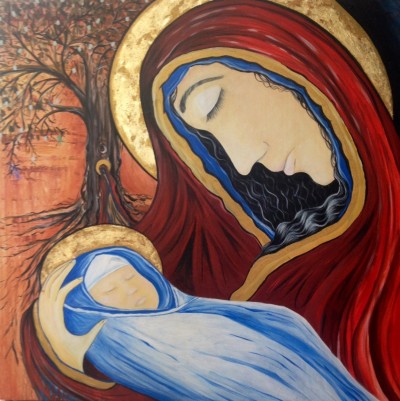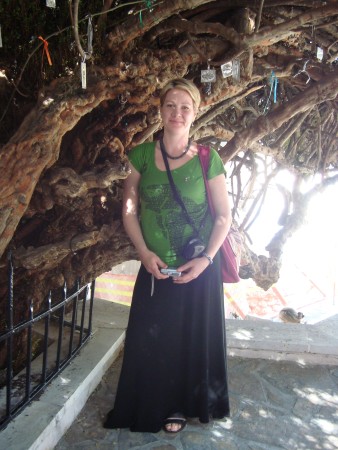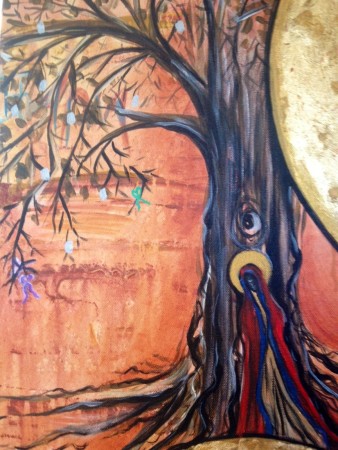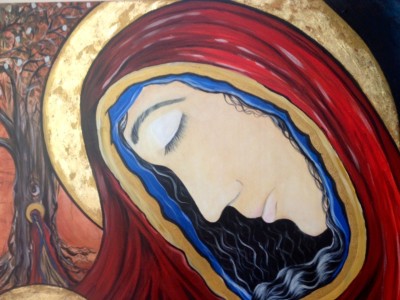I was brought up in a household where attitudes to God and church were quite negative. My Nanna, however, was deeply religious, and I can still remember sitting in her dining room as a very young child staring up in awe at a painting of ‘The Last Supper.’ I was completely mesmerised, there was something haunting about that painting that left a lifelong impression. Art became a passion very early on in life, and whenever I came into contact with images of a religious nature emotions stirred. I was spellbound by divine mystery. The most profound feelings were engendered when I met with images of Mother Mary and the infant Jesus.
Mary is known by many names: Mary, Miriam, Maria, Mother Mary, the Virgin Mary, and the Blessed Virgin Mary. In the Catholic, Eastern Orthodox, and Lutheran traditions Mary is referred to as ‘Mother of God’ or ‘Theotokos’ – ‘Bearer of God.’ Across all the major Christian traditions, beliefs and devotional practice surrounding Mary are diverse. In some traditions Mary plays a minimal role, while in others, such as the Catholic, she is the Queen of Heaven and Mother of the Church. Whilst travelling through Europe and some parts of Britain, it is hard to ignore the deep reverence held for Mary. I found myself drawn to her presence in churches, chapels, and convents. Despite not following any form of organised religion, I lit candles, kissed her icons, and prayed to her for miracles.
All religions testify to miracles, and miracles of the Madonna abound in great numbers. The word miracle is derived from the old Latin word miraculum meaning ‘something wonderful.’ There are many varying religious and scientific definitions of ‘miracle.’ Hume defines it as “a violation of the laws of nature…a transgression of a law of nature by a particular volition of the Deity, or by the interposition of some invisible agent.” (1748) Journalist Tim Stafford in his book Miracles: A Journalist Looks at Modern-Day Experiences of God’s Power asserts that ‘a miracle should be reserved for events that are surprising and revelatory.’ For me these definitions are restrictive, I believe that a miracle can essentially be whatever you want it to be. If the word simply means ‘something wonderful’ then there is much that can be considered a miracle. One does not have to be religious to believe in miracles. I have faith that miracles can and do happen.
While touring Crete recently with Carol Christ, we visited the Paliani Convent not far out of Heraklion. Paliani is one of the oldest convents still in use on Crete and dates back to the first Byzantine period–it was mentioned as old in A.D 668. The convent has a long history of various occupations, invasions, and destruction. Paliani is best known for its miracle-working Madonna and the sacred or holy Myrtle Tree which is said to be over 1000 years old. Inside the trunk of the tree is believed to be the icon of Panagia Myrtiotissa, Virgin Mary of Myrtle. Legend has it that the Panagia was removed from the tree a number of times, yet somehow the icon kept making its way back to the tree, eventually becoming enclosed in the tree as it grew. Many offerings hang from its branches, as the story of the re-appearing Panagia is considered miraculous. Interestingly, the worship of Holy Myrtle is not a Christian tradition, but rather is a survival of much older pagan practices: the worship of sacred trees was also a significant practice in ancient Minoan traditions.
Despite its tumultuous history, the convent is a sanctuary of serenity. We made our silent vigils lighting candles and praying to the dark Madonna in the chapel. We sat under the dense canopy of the Holy Myrtle tree and listened to one of Carol’s moving stories. Laughter soon followed as one of the nuns gathered with us and told her own stories in Greek and sang to the tree–all the while coveting a beautiful young goddess from our group and attempting to convince her to join the nunnery. We tied coloured ribbons on the branches of the tree and prayed for miracles. A semi-circle was formed around the tree and with joined hands we sang ‘The tree shall be well, the tree shall be well, all manner of things shall be well,’ replacing ‘tree’ with each of our names in turn.
An invitation to take refreshments with the Mother Superior was a blessing. The motherly love and affection the nuns displayed for Carol was touching. As I returned to the bus armed with trinkets and souvenirs of Mother Mary and the Holy Myrtle and turned to look one last time at the majestic beauty of the place, I was overcome with feelings of love, peace and gratitude. Thoughts of the miracle I prayed for came to mind. We were told that if our prayers came to pass, a letter to the nuns with a gift to the Panagia would be welcomed; they had already received many letters and gifts testifying that miracles had occurred.
 My latest painting ‘Παναγία’ (Panagia – pronounced pan-a-yee-ah), the feminine form of the ‘All-Holy,’ is inspired by my visit to the Paliani convent. For me Mary represents the Divine Mother and the Divine Feminine. For some she is the feminine face of God. She reminds me that even within the confines of patriarchy–and within traditions we may be ideologically opposed to–‘She’ is present. By painting her image I feel that I am contributing to the re-awakening of the Divine Feminine in all aspects of life and across all traditions. I also set out to capture a mother’s deep love for her child, while at the same time acknowledging mothers who have lost a child, those who are not able to have or are yet to have children, and all those who have lost their mothers. The tree with its roots descending deep into the earth, and the Panagia emerging from its trunk not only represents the Holy Myrtle, but is symbolic of the tree of life itself. This painting is a reminder that miracles can happen. I know, because mine is still unfolding.
My latest painting ‘Παναγία’ (Panagia – pronounced pan-a-yee-ah), the feminine form of the ‘All-Holy,’ is inspired by my visit to the Paliani convent. For me Mary represents the Divine Mother and the Divine Feminine. For some she is the feminine face of God. She reminds me that even within the confines of patriarchy–and within traditions we may be ideologically opposed to–‘She’ is present. By painting her image I feel that I am contributing to the re-awakening of the Divine Feminine in all aspects of life and across all traditions. I also set out to capture a mother’s deep love for her child, while at the same time acknowledging mothers who have lost a child, those who are not able to have or are yet to have children, and all those who have lost their mothers. The tree with its roots descending deep into the earth, and the Panagia emerging from its trunk not only represents the Holy Myrtle, but is symbolic of the tree of life itself. This painting is a reminder that miracles can happen. I know, because mine is still unfolding.
Jassy Watson, who lives on the sub-tropical coast of Queensland Australia, is a mother of four, a passionate organic gardener, an artist, and a student of ancient history and religion at Macquarie University, Sydney. She runs a small business Goddesses Garden to keep women’s sacred circles, art, music and gardening practices alive. In the photo of her, Jassy is standing under the Sacred Myrtle Tree of Paliani. Ribbons and amulets on the tree represent prayers and gratitude.





Dear Jassy, your painting is ‘something wonderful.’ showing that the Sacred Myrtle Tree does indeed work her miracles in our day.
LikeLike
Jassy, beautiful words and beautiful painting. May her miracles keep you and your family safe.
LikeLike
Jassy, your painting is so evocative of the Spirit and the Feminine. I found myself seeing the tree first as “alive” with any open above the Sacred figure of Mary, then I looked and saw the eye was a crescent moon and a star. At least that’s what I see and this connects me more deeply to your painting.
You touch the soul.
Thank you.
LikeLike
Thank you for sharing your sense of the miraculous in words and images. Miracles abounding!
LikeLike
A beautiful painting of the Mother Goddess. May your miracle keep unfolding.
LikeLike
It’s amazing how much symbology is in the painting – much of it painted subconsciously. The crescent moon appeared on its own – it wasn’t painted intentionally, then when I looked further I found many things are shaped like a crescent moon, even Mary’s hand. I love it when a painting appears to you as the artist rather than the other way around. My mum pointed out to me that the inner ochre/gold edging of Mary’s cloak is shaped like an umbilical chord which leads to baby Jesus, her cloak being womb like in its deep and vibrant redness. There is so much more to be read here, but I’ll leave that up to the viewer.
LikeLike
I just read a fascinating idea in the newest “Smithsonian” (in an article about Emma and Charles Darwin’s home, Down House) which I think fits here. The author, Rebecca Stott, writes “In his book, ‘Art Matters,’ the art theorist Peter de Bolla claims that we must attend to what paintings ‘know,’ what knowledge they contain in themselves that is separate from what their makers might have known.'”(Stott, in her piece, considers the Darwins’ house itself the “painting.”)
Jassy, I think this may connect with what you suggest in your last statement: that the work of art operates on many levels: what the artist did, what the piece of art “did,” and what the viewer(s) add to the work. I like the idea of the wisdom, if you will, of the art itself. This seems to add a whole extra layer of possible meaning to the work.
Archetype, allegory, icon? The fact that one doesn’t have to make a reductive choice in your art seems to dovetail nicely with the many-faceted “nature” of the “She Who Changes.”
LikeLike
Jassy — I wish I knew how to download an image into this conversation, because your painting reminds me of another one that my daughter painted for me as a Solstice present many years ago. It was the first of three: the Mother, the Maiden, and the Crone. Thanks for evoking that image as well as beautifying my life with yours.
LikeLike
Nancy you may be able to photograph the image or scan the image and then open it, copy it and paste it into the reply box.
LikeLike
Onoosh, I am interested in what you have written about the article by Stott. I believe that when we as artists (the many forms of) tap into our creative intuition and create on an energetical level the work kind of creates itself. Hali Karla (Sacred Art of Women) has just written a beautiful blog about the intimate dance artists have with their creations – the push and the pull, the struggle, the flow, the joy, the frustration; so while the end result may be beautiful the process for us comes from a very deep place within. For many years I painted what I thought people wanted to buy, not showing much of my inner wisdom and holding the work back from showing its’ own wisdom. My work was technically great and I’ve sold plenty over the years but I didn’t bear my heart and soul on the canvas. I have found my creative mojo once again – or maybe it found me, thanks to a life-changing trip to Crete. When I am painting it’s like someone else is doing it for me. It’s taken me some time to move my art practice onto a spiritual level, to create my art space as sacred space and to realise the work that I do is sacred and part of a very long tradition; from the first images drawn on caves to the present. I am blessed to have the space to show it and speak about it. I love sharing :)
LikeLike
Jassy, I’m so glad I’ve “met” you thru the Sacred Art of Women site. You are inspiring and very affirming for me, like a kindred soul. Under the guidance of Chris Zydel I’ve spent several years opening to the mysteries within and letting them come out through my paintings. They are never planned, they just appear and I trust that process. I’ve also spent many years connecting with a lot of goddesses and creating ceremony and sacred space to share with others. So, your work really resonates/vibrates with me. It’s so lovely to see and read about your journey. Thank you.
LikeLike
For me the writing process is somewhat similar. When it is really happening, it flows out of me from a place within that I don’t have fully conscious access to. Rereading things I wrote years ago, I am often surprised: did I really know that then, I ask myself. I may have written it but in many cases “I” didn’t know it fully yet.
LikeLike
Wish to nurture this kind of technique Carol. How can I?
LikeLike
Jassy, your artwork is so beautiful. It is a gift to be able to view your work and to read your words. You are gift to women everywhere.
LikeLike
Thank you Alexis. Very kind words indeed. You are a gift too sister xx
LikeLike